ALL HANDS ON DECK






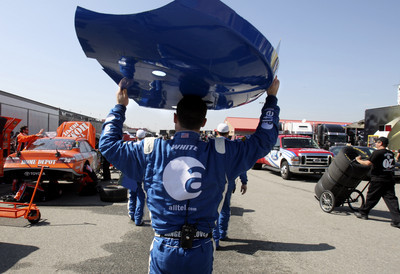
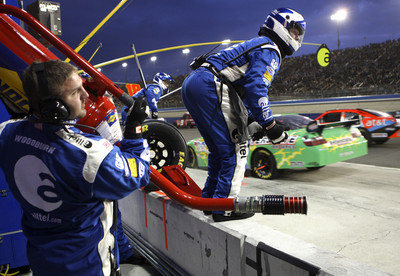
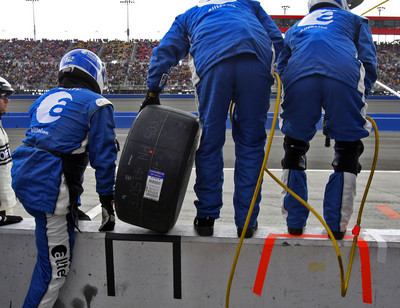
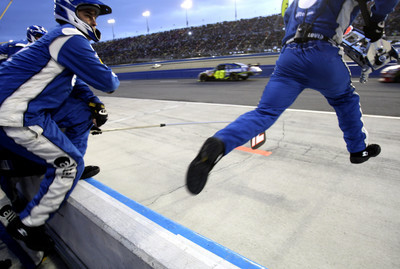
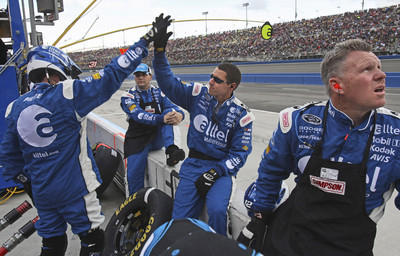
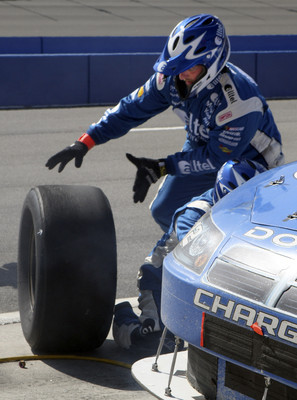
NASCAR teams will spend millions of dollars to trim a tenth or hundredth of a second off a car’s lap times, but a good pit crew can pick up precious seconds with a lightning-quick stop that resembles ballet played at triple fast forward.
A pit stop is a performance by seven athletic men dressed not in tutus and ballet slippers, but bulky fire-protective suits and helmets. The dance is choreographed to the tune of a 185 mph race-car parade and the high-pitched whir of air-powered impact wrenches.
Tire changers, gas men, jack men all work together, setting aside differences with one common goal: a four-tire pit stop in the range of 12 to 13 seconds.
"Our time is important, but it’s more important to get the stop done right," said Trent Cherry, the rear-tire carrier and pit crew coach for the No. 12 Alltel Dodge driven by Ryan Newman.
PRESSURE IN THE PITS
As the pit crew coach for nine racing teams at Penske Racing — from three stock cars and two IndyCars to sports cars — Cherry recruited five of the members of Newman’s team.
Spending weekends traveling and two long days at a track can fray nerves. Pressure is compounded by the intensity of races that can last up to four hours.
One loose lug nut, a tire that rolls away or a tool left attached to a car can cost the team several positions in the running order or, worst of all, a crash.
"We can’t make mistakes,” Cherry said. ”A mistake can be expensive or get our driver hurt."
Newman’s team was flawless two weeks ago when his crew helped him win the Daytona 500, good for a $1.5 million payday.
With so much money at stake, rules are stringent. If a member misses one race for an unacceptable reason, he’s fired.
Crewmen’s contracts require specific provisions: tire changers must be able to run a 40-yard dash within a specified time; strength must be maintained by the carriers, jack man and gas man.
Cherry would not reveal how much his teammates are paid, but said, "You can make a living on it."
The wear on traveling crewmen isn’t just on knees and backs — and families. Cherry, tire changer Joe Piette Jr. and gas man George Whitley work full time for Penske. Others have jobs that allow for scheduling flexibility.
ALL FOR ONE …
The glory of competing before 250,000 spectators at Daytona or 145,000 at Las Vegas Motor Speedway, with millions more watching on TV, can boost the egos of some weekend pit road warriors. The banter among the group, except during races, prevents anyone’s ego from getting overinflated.
But it’s not all fun and glory. Racing can be the crewmen’s only priority on almost every weekend. That can lead to steady turnover, with few members surviving on pit road more than 10 years.
Piette, 39, is a rarity. As a tire changer, the most pivotal and demanding role, he’s in his 20th year working on pit road with five different teams. This is his fifth year with Penske.
"Before winning Daytona, we hadn’t won a race in 21/2 years, but we didn’t lose one guy," Piette said. "That says a lot about our team and how we get along."
Cherry says Piette has two or three good years left as a changer, but Piette isn’t so sure. He’s in top shape, but missing precious weekends with his family eventually takes a toll.
It’s not just leaving his home on Saturdays on a Penske jet and returning late on Sundays, barring a rain delay to Monday like last weekend at Auto Club Speedway in Fontana, Calif. The crew also must attend weekly training and practice sessions at the Penske shop outside of Charlotte, N.C., where members review videotapes of the most recent pit stops.
After joining the team eight years ago as a changer, Cherry began applying what he learned as a high school and college quarterback breaking down game films to evaluate pit stops frame by frame, step by step.
THE TEAM
Agility, quickness and hand-eye coordination are most critical for tire changers, who use impact wrenches to remove and replace five lug nuts in a blur.
Tire carriers — Cherry is paired with Piette and Scott Reiniger with Ben Brown — quickly "hang" a 70-pound tire the moment their changer removes the used one.
The strongmen are the gas can man, George Whitley, and the jack man, 26-year-old rookie Bryan White, a former linebacker for the University of Virginia. Both are 6 feet 2 inches and weigh about 220 pounds.
Whitley manhandles 80-pound cans filled with 12 gallons of racing fuel like they’re bottles of water, and White flies to the right side of the car, then around the front to the left side, toting a 20-pound floor jack.
The team’s former longtime jack man, 40-year-old Britt Goodrich, is in superb condition, but this season he had to step aside to make room for White. Goodrich took over as the fuel catch-can man, the least physically demanding role on the over-the-wall gang.
"I’m still very competitive as a jack man, so it’s been a hard adjustment for me," Goodrich said. "But it’s a good move for the team. That’s what matters."
Goodrich’s willing acceptance of what’s essentially a demotion is an indication of why Piette says the team is the most closely knit on which he has worked.
"This is a young man’s game and we’ll all be replaced one day," Cherry said.
Crewmen know their days on pit road are limited. Pit road is a locker room without lockers, and one day they’ll only be able to visit.
Contact reporter Jeff Wolf at jwolf@reviewjournal.com or (702) 383-0247.
View slideshow

















